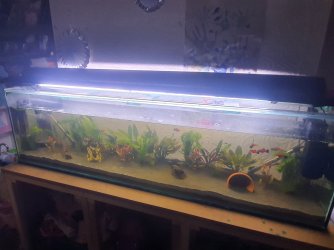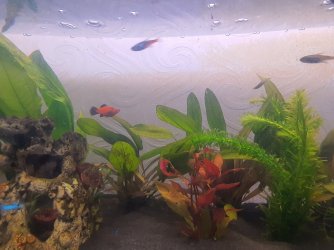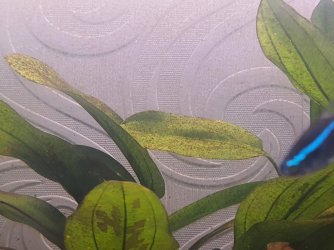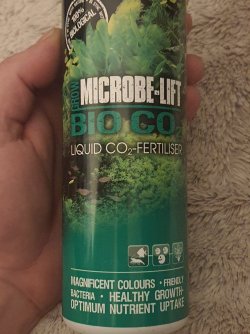In my tank ive noticed ive been developing a brown algae on the surface of the glass and its also covering a decent portion of some of the leaves on my plants. It is a relatively new tank but I believe its just about finished its cycle (learned the hard way). I am due to replace the carbon filters in my filter. Could this be down to this or a lighting issue? I have 2x strip lights that say 10k on them. I do have some alternanthera cardinalis variegata plants in there that just seem to be getting eaten/falling apart and not growing
You are using an out of date browser. It may not display this or other websites correctly.
You should upgrade or use an alternative browser.
You should upgrade or use an alternative browser.
Brown algae
- Thread starter Steve2717
- Start date
The April FOTM Contest Poll is open!

🏆 Click to vote! 🏆
A photo might confirm the "algae," but if it is brown and if it will easily come off using your fingertips on the plant leaves it is probably diatoms. Diatoms are common in new tanks because the tank's biological system is not established and when nutrients are present in the tank light (or ambient daylight even) algae is ready to take advantage. Algae unlike higher plants is not demanding as to the type of light. So no issues so far that will not likely sort themselves out as the tank established. And note, establish is not cycled, the cycling is stage one but then the tank will develop a biological system depending upon the light (intensity and spectrum), plant species and numbers, and fish load.
However, this brings me to the light spectrum. The Kelvin number, which is the colour temperature of light, is here said to be 10,000K (assume this is what you meant); this is high in the blue wavelength which means much less red/green. This will affect plants, and be advantageous to other algae. We can discuss if you ask.
However, this brings me to the light spectrum. The Kelvin number, which is the colour temperature of light, is here said to be 10,000K (assume this is what you meant); this is high in the blue wavelength which means much less red/green. This will affect plants, and be advantageous to other algae. We can discuss if you ask.
I started the tank on the 17th of sept, rushed into without knowing anything and have been trying to rectify the situation. It came with the strip lights which are yes 10000k. I saw a previous thread where you had mentioned this and I have also read that too much light could cause the algae which is what brought me to the question. Here is pictures of the tank with the lights along with a pic of the algae which is covering the back of the tank and another of one of the leaves. Hope this helps. I will be building a proper lid for the tank and to house the lights as the bar is too long and doesn't sit well but if the lights are no good I can look at alternativesA photo might confirm the "algae," but if it is brown and if it will easily come off using your fingertips on the plant leaves it is probably diatoms. Diatoms are common in new tanks because the tank's biological system is not established and when nutrients are present in the tank light (or ambient daylight even) algae is ready to take advantage. Algae unlike higher plants is not demanding as to the type of light. So no issues so far that will not likely sort themselves out as the tank established. And note, establish is not cycled, the cycling is stage one but then the tank will develop a biological system depending upon the light (intensity and spectrum), plant species and numbers, and fish load.
However, this brings me to the light spectrum. The Kelvin number, which is the colour temperature of light, is here said to be 10,000K (assume this is what you meant); this is high in the blue wavelength which means much less red/green. This will affect plants, and be advantageous to other algae. We can discuss if you ask.
Attachments
The algae looks like diatoms, the key though is if it will easily come off the plant leaves using your fingertips. If yes, we can sort this out as explained previously.
The light doesn't appear too cool (blue) in the photos, but 10000K is likely going to be problematical. We can however try to work around this and see, if you are not wanting to invest in better lighting. Can you replace the rows of diodes, or are they it? Getting one row warmer could probably work.
I have always relied on Kelvin ratings, and never had issues. The lower K number the "warmer" and the higher the "cooler." Meaning more or less red and blue. A K around 5000K to 6500K is ideal, very close to the sun for plants. One issue with high blue is algae. I've had 10000K and even 11000K in a combo and not only did the plants struggle more, my problem algae was increased.
Are you using any plant fertilizers at all, and if yes, which? Aim here is to get the plants off to a good start.
The light doesn't appear too cool (blue) in the photos, but 10000K is likely going to be problematical. We can however try to work around this and see, if you are not wanting to invest in better lighting. Can you replace the rows of diodes, or are they it? Getting one row warmer could probably work.
I have always relied on Kelvin ratings, and never had issues. The lower K number the "warmer" and the higher the "cooler." Meaning more or less red and blue. A K around 5000K to 6500K is ideal, very close to the sun for plants. One issue with high blue is algae. I've had 10000K and even 11000K in a combo and not only did the plants struggle more, my problem algae was increased.
Are you using any plant fertilizers at all, and if yes, which? Aim here is to get the plants off to a good start.
I havent touched the algae yet but will have a look tomorrow as ive turned the lights off for the night. They are flourescent tubes so dont think I can turn them down. If they are going to be a problem I will look at changing them. They are both fitted either side of a bar which is too long for the tank but I wanted to split them if I could so that the center would be accessible for water changes and substrate vac but my brother doesn't think its achievable. Although I'm an engineer and could probably make something work, it would be a waste of time and effort if its not going to suit its purpose. Ive bought fertiliser to help the plants I mentioned above but as I was already treating the tank for ich (which ive just cleared) I havent got round to putting any in yetThe algae looks like diatoms, the key though is if it will easily come off the plant leaves using your fingertips. If yes, we can sort this out as explained previously.
The light doesn't appear too cool (blue) in the photos, but 10000K is likely going to be problematical. We can however try to work around this and see, if you are not wanting to invest in better lighting. Can you replace the rows of diodes, or are they it? Getting one row warmer could probably work.
I have always relied on Kelvin ratings, and never had issues. The lower K number the "warmer" and the higher the "cooler." Meaning more or less red and blue. A K around 5000K to 6500K is ideal, very close to the sun for plants. One issue with high blue is algae. I've had 10000K and even 11000K in a combo and not only did the plants struggle more, my problem algae was increased.
Are you using any plant fertilizers at all, and if yes, which? Aim here is to get the plants off to a good start.
I havent touched the algae yet but will have a look tomorrow as ive turned the lights off for the night. They are flourescent tubes so dont think I can turn them down. If they are going to be a problem I will look at changing them. They are both fitted either side of a bar which is too long for the tank but I wanted to split them if I could so that the center would be accessible for water changes and substrate vac but my brother doesn't think its achievable. Although I'm an engineer and could probably make something work, it would be a waste of time and effort if its not going to suit its purpose. Ive bought fertiliser to help the plants I mentioned above but as I was already treating the tank for ich (which ive just cleared) I havent got round to putting any in yet
Attachments
That isn't actually a fertiliser, it is liquid CO2, though unlike most of those the website says it contains humic acid rather than glutaraldehyde.
What you need is something like Seachem Flourish Comprehensive Supplement for the Planted Aquarium. Byron is better at explaining than me, but fish breathe out CO2 and micro-organisms in the substrate make it so unless you have a lot of high tech plants you don't need to add this.
What you need is something like Seachem Flourish Comprehensive Supplement for the Planted Aquarium. Byron is better at explaining than me, but fish breathe out CO2 and micro-organisms in the substrate make it so unless you have a lot of high tech plants you don't need to add this.
Damn, fish shop guy got me. Thought it might help the alternanthera cardinalis variegata I bought that just seem to be dying (literally falling apart or getting eaten). Glad I've not put it in nowThat isn't actually a fertiliser, it is liquid CO2, though unlike most of those the website says it contains humic acid rather than glutaraldehyde.
What you need is something like Seachem Flourish Comprehensive Supplement for the Planted Aquarium. Byron is better at explaining than me, but fish breathe out CO2 and micro-organisms in the substrate make it so unless you have a lot of high tech plants you don't need to add this.
The light issue may be partly solved for the present. If these are T8 fluorescent tubes, in the 48-inch/121.9 cm length, this is what I had for over 20 years on my three largest tanks. Two tubes per fixture. The problem though might be finding them. Essjay has mentioned elsewhere that the UK is phasing out T8 fluorescent lighting. But if you can still get them, try home improvement places like Home Depot, Lowe's, or similar if these chains are not in the UK. These home improvement stores may still carry T8, and either Sylvania or Phillips are good brands. I used one 6500K Daylight and one 5000K tube (can't remember the name) and together this is absolutely ideal light for a planted tank. If only one of these is available, two of them will be fine. Problem is obviously that these may well be phased out before you next need more...these T8 tubes lose enough intensity after 12 months that they need replacement or the plants will weaken and algae increase. But so long as you can get them, they will work.
I found earlier this year that I was having real difficulty getting smaller replacement tubes, reason the same, being phased out in favour of less energy LED. Had to go to LED.
I found earlier this year that I was having real difficulty getting smaller replacement tubes, reason the same, being phased out in favour of less energy LED. Had to go to LED.
My observations on Microbe Lift Bloom and Grow Bio Carbon.
In their data, they seem careful not to say it is the macro-nutrient carbon. They talk about decomposition, end product being humic acid.
That doesn't sound necessarily bad, but where exactly is the carbon the plants need? Unless someone can show this, save your money.
On a comprehensive fertilizer, another good choice since you are in the UK is TNC Lite.
In their data, they seem careful not to say it is the macro-nutrient carbon. They talk about decomposition, end product being humic acid.
- Contains high quality peat extract
- Contains humic and fulvic acids
- Contains a blend of naturally occurring vegetative and spore-forming microorganisms
- Helps make iron, nitrogen and other nutrients more bioavailable
That doesn't sound necessarily bad, but where exactly is the carbon the plants need? Unless someone can show this, save your money.
On a comprehensive fertilizer, another good choice since you are in the UK is TNC Lite.
Yes thats sounds like them, ill have a look but I think if im changing them I'll probably lean towards getting LED as may come in a better layout as this fitting blocks the middle of the tank meaning it has to be moved out of the way when cleaning the tankThe light issue may be partly solved for the present. If these are T8 fluorescent tubes, in the 48-inch/121.9 cm length, this is what I had for over 20 years on my three largest tanks. Two tubes per fixture. The problem though might be finding them. Essjay has mentioned elsewhere that the UK is phasing out T8 fluorescent lighting. But if you can still get them, try home improvement places like Home Depot, Lowe's, or similar if these chains are not in the UK. These home improvement stores may still carry T8, and either Sylvania or Phillips are good brands. I used one 6500K Daylight and one 5000K tube (can't remember the name) and together this is absolutely ideal light for a planted tank. If only one of these is available, two of them will be fine. Problem is obviously that these may well be phased out before you next need more...these T8 tubes lose enough intensity after 12 months that they need replacement or the plants will weaken and algae increase. But so long as you can get them, they will work.
I found earlier this year that I was having real difficulty getting smaller replacement tubes, reason the same, being phased out in favour of less energy LED. Had to go to LED.
Thank you and Essjay for the suggestions will pick some up, this is my first attempt at setting aquarium up so im still learning all this stuffMy observations on Microbe Lift Bloom and Grow Bio Carbon.
In their data, they seem careful not to say it is the macro-nutrient carbon. They talk about decomposition, end product being humic acid.
When plants are removed from the environment where they are grown, natural balances are destroyed and growth may be disrupted. It is a good practice to restore the plants natural balances with MICROBE-LIFT/BLOOM & GROW Bio-Carbon. Dosing with MICROBE-LIFT/BLOOM & GROW Bio-Carbon is the most convenient and effective method of restoring these balances.
- Contains high quality peat extract
- Contains humic and fulvic acids
- Contains a blend of naturally occurring vegetative and spore-forming microorganisms
- Helps make iron, nitrogen and other nutrients more bioavailable
That doesn't sound necessarily bad, but where exactly is the carbon the plants need? Unless someone can show this, save your money.
On a comprehensive fertilizer, another good choice since you are in the UK is TNC Lite.
Latest Discussions
- Replies
- 6
- Views
- 95





